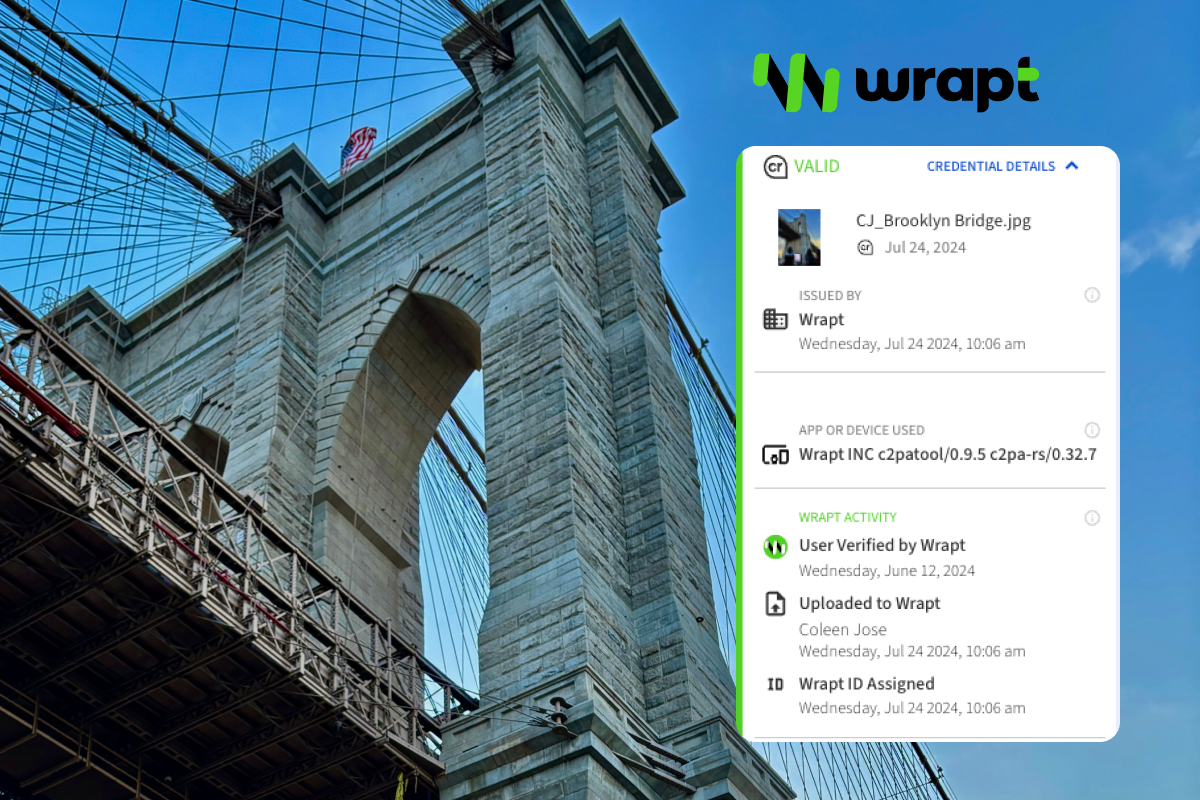How Wrapt’s end-to-end platform protects creative workflows with Content Credentials

When singer and songwriter Ella Janes finishes recording a new music track, she burns the audio file to a CD, prints a copy of the lyrics, and mails both items to herself in a package. She doesn’t do this to fill time or indulge a 2000s-era pastime — she does it to protect her intellectual property.
She’s been advised to follow this process as a way to prove that she created a song on a particular date as prior art. If we can notarize important documents like deeds and passport applications, why not have a process for establishing the authenticity and origins of digital assets like audio files?
Establishing provenance in the era of digital theft and deepfakes
Digital theft is a widespread issue, with visits to piracy websites up 12% since 2019 (about 386 million visits per day) and an estimated cost to the US economy of $29 billion in lost revenue each year. Generative AI technology is adding to the growing problem, giving us everything from viral tracks and deepfaked vocals of musicians Drake and the Weeknd to Federal Trade Commission warnings about the increasing rise of deepfake scams. These issues are impacting individual consumers, artists, and the world’s largest enterprises.
Ella Janes’s father, Mark Janes, and Stuart Waite are veterans of the creative industry. Stuart has a degree in journalism and works extensively with major publishing and TV production companies, and Mark has worked with the BBC and other production companies as an editor, videographer, producer, and director.
Mark and Stuart’s deep understanding of content workflows and the effort involved in crafting and publishing creative and journalistic work led them to build and launch Wrapt™.
The creative-first platform uses the open C2PA Content Credentials standard and integrates with leading creative tools and devices to establish and maintain the provenance and authenticity of images, audio, and video.
I got an early look at Wrapt as the company is an active member of the Content Authenticity Initiative (CAI) community. I used Wrapt to add Content Credentials to my photographs and try out an important tool, sharing my signed files with partners I’d selected. Wrapt offers an end-to-end workflow that maintains assets’ credentials and securely distributes assets both publicly and to trusted collaborators.
I recently spoke to Mark and Stuart about the hurdles that artists like Ella have to overcome to protect their work, and about the opportunity to create a flexible platform for digital authenticity. The Wrapt founders shared how they’ve implemented Content Credentials, their tips for getting started and contributing to the ecosystem, and why provenance is critical for proving ownership and protecting creative work.
This interview has been edited for length and clarity.
How would you describe Wrapt?
Stuart: In an era of deepfakes, content theft, and plagiarism, Wrapt provides an industry solution to millions of content creators, brands, and publishers seeking to protect and insure their creative assets. It's as simple as wrap it, share it, track it!
Wrapt is a B2B SaaS content protection platform. With Content Credentials, Wrapt protects and insures your creative work by securely tracking how it’s created, shared, and published across the internet.
We founded Wrapt in 2022 and incubated it in the Exit Velocity Venture Studio, which took it through MVP to Beta release.

Tell us about your beta release.
Mark: Wrapt Beta is an early release that will wrap and authenticate various types of images, audio files, and video files while also supporting accredited tools from leading software providers. We believe it will help people in the creative industry start to authenticate the more than 34 billion unprotected images online, and it will also help them protect their audio and video assets.
But we aren’t stopping there. Over the next few months we’ll integrate with a wide range of creative tools and enable protection for even more file formats. We’ll extend support for a broader range of watermarking and fingerprinting technologies that are complementary to the C2PA standard. We’ll also release features to ensure that each asset can define its unique usage rights for publishing, collaboration, or paid usage.
There's also streaming audio and video, AR/VR, games, and anything else our partners and the creative community believe needs to be added to Wrapt’s roadmap.
Wrapt Beta is free to use. Our paid plan will offer a discounted subscription through a Kickstarter campaign. At its core, Wrapt sells credits that enable users to wrap and protect their creative assets online. They spend one credit to wrap one creative asset. They also pay a monthly or annual subscription for additional features and capabilities within the platform.
How do Content Credentials work in Wrapt?
Stuart: Wrapt adds a signed Content Credentials manifest to all assets when uploaded to our platform. Existing manifests and credentials attached to an asset can be read and inspected on the C2PA’s Content Credentials Verify site.
Wrapt also adds an invisible watermark to each asset that’s shared publicly. Wrapt tracks who users share their assets with, and it will soon add that data to the Content Credentials themselves to further clarify an asset’s provenance.
How did you use CAI open-source tools? What challenges did you encounter during implementation?
Stuart: We used the C2PA command line tool to read and validate C2PA data in supported media files and add signed manifests to supported media files. We’ve extended the capability of these manifests to include our exclusive Wrapt Activity data, which further helps our users understand the origins of their assets.
The biggest challenge was understanding how the SDKs work and how to deploy them. It continues to be a challenge every day — especially for a small-team startup and early adopter like us.
Adapting our product as the C2PA standard evolves has also raised serious challenges for us at times. But in the startup world we’re used to this, and we embrace it as part of the opportunity.
The problem we’ve identified for our creator community is worth solving and we’re convinced the C2PA standard and CAI community are key parts of that solution.
What advice do you have for getting started with Content Credentials and open-source tools?
Mark: Become an active participant in the community and really understand what the challenges are. There are numerous working groups from UX to watermarking that you can join via the C2PA and CAI Discord, and you can participate in regular meetings. Here you can connect with a ton of very talented and knowledgeable people that all aspire to ensure that the C2PA standard provides publishers, creators, and consumers the ability to trace the origins of different types of media.
What's next?
Wrapt is raising seed capital to validate its existing MVP and user personas, and to develop the product to full launch so we can drive demand from the millions of existing content creators across the world. This is being offered to corporate investors as an equity investment in the company. End users can support our mission to ensure that everyone knows what’s authentic and what’s not by joining the Kickstarter campaign we’ll launch soon.
Anyone who’s interested can contact us at investors@wrapt.space for more information.
We’re also looking for partners — people within the existing ecosystem that we can collaborate with on new features, and also creators, brands, agencies, and publishers that want to try Wrapt within their own organizations.
Sign up here to access Wrapt beta.